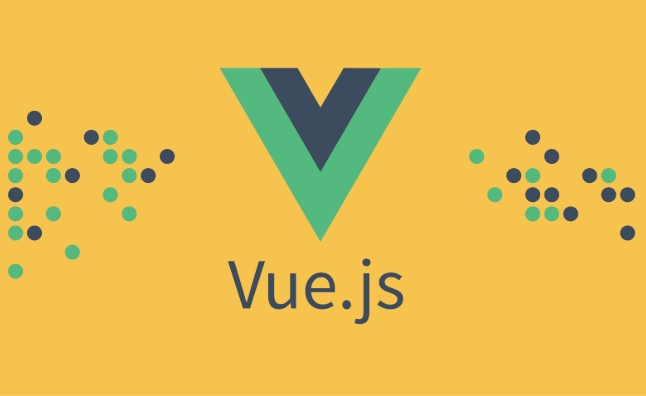Passing routing parameters using props can make components easier to reuse and test. There are three ways: ① Boolean mode: props: true Pass routing parameters as props; ② Object mode: props: { key: value } Pass static values; ③ Function mode: props: (route) => ({}) It can process parameters dynamically and pass them. The corresponding props need to be declared in the component, which is suitable for simple scenarios and improve component decoupling and maintainability.

Passing props to route components in Vue Router is a clean way to make your components more reusable and easier to test. Instead of accessing $route directly inside your component, you can enable props for a route so that route parameters, query strings, or static values are passed as regular props.

Here's how to do it in Vue 3 with Vue Router (also apply to Vue 2 with vue-router 3.1):
? Enable Props in Route Configuration
You need to set props: true in your route definition to automatically pass route params as props.

const routes = [
{
path: '/user/:id',
component: UserComponent,
props: true // This enables passing params as props
}
] With this setup, if you navigate to /user/123 , the UserComponent will receive id as a prop:
<!-- UserComponent.vue -->
<template>
<div>User ID: {{ id }}</div>
</template>
<script>
export default {
props: ['id']
}
</script>? Pass Static and Dynamic Props
You can also pass static values or mix params with static/query values using a props function :

{
path: '/news',
component: NewsComponent,
props: (route) => ({
page: parseInt(route.query.page) || 1,
category: 'technology'
})
} Now NewsComponent receives page and category as props:
<script>
export default {
props: ['page', 'category']
}
</script>This is useful when you want to pass query parameters or transform route data before passing it down.
? Using Props with Named Routes or Components
If you're using named views (like components instead of component ), you must use object syntax with named props :
{
name: 'home',
path: '/home',
components: {
default: HomeView,
sidebar: SidebarComponent
},
props: {
default: true,
sidebar: { show: true }
}
}? Don't Use Props with Route-Level Components (Sometimes)
Avoid using props if your component heavily relies on the route itself (like many params or complex logic). In such cases, using useRoute() (Composition API) or this.$route (Options API) might be clearer.
But for simple, reusable components , prefer props — it makes them easier to test and decouples them from the router.
? Summary: 3 Ways to Pass Props
- Boolean mode :
props: true→ passes route params as props. - Object mode :
props: { id: 1 }→ passes static values. - Function mode :
props: (route) => ({})→ full control over what to pass.
Example:
[
{ path: '/user/:id', component: User, props: true },
{ path: '/feed', component: Feed, props: { type: 'hot' } },
{ path: '/search', component: Search, props: route => ({ q: route.query.q }) }
] Use props when you can — it leads to cleaner, more maintained components. Just remember to define the props option in your route and declare the props in your component.
Basically, it's a small change that makes your app more modular.
The above is the detailed content of How to pass props to route components in Vue Router?. For more information, please follow other related articles on the PHP Chinese website!

Hot AI Tools

Undress AI Tool
Undress images for free

Undresser.AI Undress
AI-powered app for creating realistic nude photos

AI Clothes Remover
Online AI tool for removing clothes from photos.

Clothoff.io
AI clothes remover

Video Face Swap
Swap faces in any video effortlessly with our completely free AI face swap tool!

Hot Article

Hot Tools

Notepad++7.3.1
Easy-to-use and free code editor

SublimeText3 Chinese version
Chinese version, very easy to use

Zend Studio 13.0.1
Powerful PHP integrated development environment

Dreamweaver CS6
Visual web development tools

SublimeText3 Mac version
God-level code editing software (SublimeText3)

Hot Topics
 Can computed properties accept arguments?
Jul 02, 2025 am 12:58 AM
Can computed properties accept arguments?
Jul 02, 2025 am 12:58 AM
The computed properties of Vue.js cannot directly accept parameters, which is determined by its design characteristics, but can be implemented indirectly through the computed properties of methods or return functions. 1. Methods: Parameters can be passed and used in templates or listeners, such as formatName('John','Doe'); 2. Encapsulate the computed attributes into the form of a return function: such as formatName returns a function that accepts parameters, and call formatName()('Jane','Smith') in the template. The method of use is usually recommended because it is clearer and easier to maintain, and the way of returning functions is suitable for special scenarios where internal state and external values ??are required.
 What is headless UI in Vue?
Jul 08, 2025 am 01:38 AM
What is headless UI in Vue?
Jul 08, 2025 am 01:38 AM
HeadlessUIinVue refers to a library of UI components that provide no preset styles and only contains core logic and behavior. Its features include: 1. No style restrictions, developers can customize the design; 2. Focus on barrier-free and interactive logic, such as keyboard navigation, state management, etc.; 3. Support Vue framework integration, exposing the control interface through combinable functions or components. Reasons for use include: maintaining design consistency, built-in accessibility, strong component reusability, and lightweight library size. In practical applications, developers need to write HTML and CSS themselves. For example, when building a drop-down menu, the library handles state and interaction, while developers decide on visual presentation. Mainstream libraries include HeadlessUI and RadixVue for TailwindLabs, suitable for
 How to watch nested properties in Vue 3?
Jul 07, 2025 am 12:51 AM
How to watch nested properties in Vue 3?
Jul 07, 2025 am 12:51 AM
In Vue3, there are three ways to monitor nested properties using the watch function: 1. Use the getter function to accurately monitor specific nested paths, such as watch(()=>someObject.nested.property,callback); 2. Add the {deep:true} option to deeply monitor changes within the entire object, which is suitable for situations where the structure is complex and does not care about which property changes; 3. Return an array in the getter to listen to multiple nested values ??at the same time, which can be used in combination with deep:true; in addition, if ref is used, the nested properties in its .value need to be tracked through getter.
 How to build a component library with Vue?
Jul 10, 2025 pm 12:14 PM
How to build a component library with Vue?
Jul 10, 2025 pm 12:14 PM
Building a Vue component library requires designing the structure around the business scenario and following the complete process of development, testing and release. 1. The structural design should be classified according to functional modules, including basic components, layout components and business components; 2. Use SCSS or CSS variables to unify the theme and style; 3. Unify the naming specifications and introduce ESLint and Prettier to ensure the consistent code style; 4. Display the usage of components on the supporting document site; 5. Use Vite and other tools to package as NPM packages and configure rollupOptions; 6. Follow the semver specification to manage versions and changelogs when publishing.
 How to create a Vue 3 project with Vite?
Jul 05, 2025 am 01:39 AM
How to create a Vue 3 project with Vite?
Jul 05, 2025 am 01:39 AM
It is recommended to use Vite to create Vue3 projects because it uses the browser's native ES module support and has a fast startup speed in development mode. 1. Make sure to install Node.js (16.x or higher) and npm/yarn/pnpm; 2. Run npmcreatevite@latestmy-vue-app--templatevue initialization project; 3. Follow the prompts to select TypeScript, VueRouter and other configurations; 4. Execute cdmy-vue-app and npminstall installation dependencies; 5. Use npmrundev to start the development server. Optional configurations include automatic browser opening, proxy settings, alias paths, and packaging optimizations. Recommended insurance
 Key differences between Vue 2 and Vue 3?
Jul 09, 2025 am 01:29 AM
Key differences between Vue 2 and Vue 3?
Jul 09, 2025 am 01:29 AM
Vue3 has improved in many key aspects compared to Vue2. 1.Composition API provides a more flexible logical organization method, allowing centralized management of related logic, while still supporting Vue2's Options API; 2. Better performance and smaller package size, the core library is reduced by about 30%, the rendering speed is faster and supports better tree shake optimization; 3. The responsive system uses ES6Proxy to solve the problem of unable to automatically track attribute addition and deletion in Vue2, making the responsive mechanism more natural and consistent; 4. Built-in better support for TypeScript, support multiple node fragments and custom renderer API, improving flexibility and future adaptability. Overall, Vue3 is a smooth upgrade to Vue2,
 How to define routes in vue router?
Jul 05, 2025 am 12:58 AM
How to define routes in vue router?
Jul 05, 2025 am 12:58 AM
Defining routes in Vue projects requires understanding the structure and configuration. The steps are as follows: 1. Install and introduce vue-router, create a routing instance, and pass in a routes array containing path and component; 2. Use dynamic routing matching such as /user/:id to obtain parameters; 3. Use children attribute to implement nested routes; 4. Name the routes with the name attribute for jumping; 5. Use redirect for path redirect. After mastering these core points, you can configure routing efficiently.
 What are Vue devtools?
Jul 02, 2025 am 12:11 AM
What are Vue devtools?
Jul 02, 2025 am 12:11 AM
VueDevtools is a browser extension for debugging Vue.js applications, providing real-time viewing and editing functions of component structure, props, data, etc. 1. Installation method: Search for "Vue.jsdevtools" in Chrome or Firefox browser and add extensions; 2. Enable method: During local development, you need to set Vue.config.devtools=true in the entry file; 3. Core functions: component tree viewing, props and data tracking, event monitoring, performance timeline analysis; 4. Frequently asked questions: Ensure a non-production environment, register Vuexstore correctly, use a beta version that is suitable for Vue3, and try independent Elec






